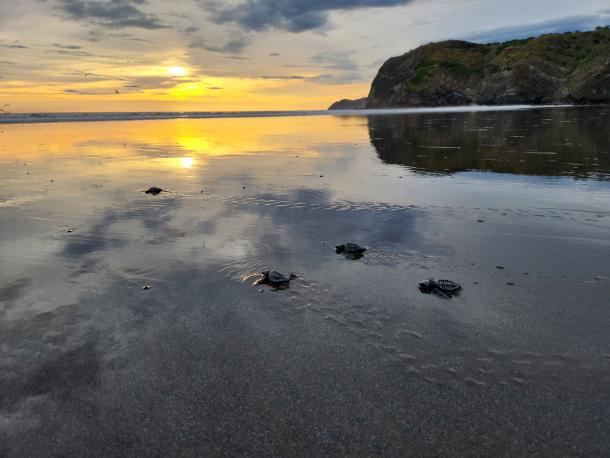
Baby Olive Ridley sea turtles make their way from their nesting site on Playa Nancite to the Pacific Ocean. Photo by Luis Fonseca.
In a new paper in the journal Marine Ecology, “Reassessement of the Olive Ridley Sea Turtle Lepidochelys olivacea Nesting Population at Nancite Beach, Costa Rica,” turtle biologist Luis Fonseca reports on his findings from over 10 years of studying the turtles of Playa Nancite. In the paper, Fonseca notes that the arribadas, or synchronous mass-nesting events, these turtles are famous for, decreased in magnitude at this beach by about 90 percent during the period 1971-2007 due to unknown causes. The present study looked at the time period of 2009-2021, when a total of 62 mass-nesting events occurred with an estimated annual average of 64,694 nesting females. There was a 14 percent documented increase in the number of females per arribada event during the study period. The mean hatching rate was estimated at 33.4 precent, resulting in an overall estimated production average of 2,165,597 nestlings per season, an increase of 82.7 percent as compared to the period 1980-1984, when the arribadas were larger. Fonseca suggests “that the growth in hatchling production over the past four decades is at least in part responsible for the slight increase in the estimated size of arribadas since 2009/2010. However, because maximal hatching success did not increase above 60%, the beach may be close to reaching carrying capacity, and it seems that high hatchling production may soon level off or begin to decrease. Thus, it is not clear whether current hatchling production will lead to the recovery of the Nancite population to the historical levels documented in the 1970s and early 1980s.” He adds that “only the sustained, long-term monitoring of this important rookery may yield the necessary insight to provide an improved understanding of the mechanics of the arribada phenomenon at this beach.” Fonseca’s work is supported by GDFCF, ACG, SEE Turtles, and a number of individual donors. If you would like to donate to this important sea turtle research, you can do so here. Please make a note that the donation is for turtle research. And thank you.